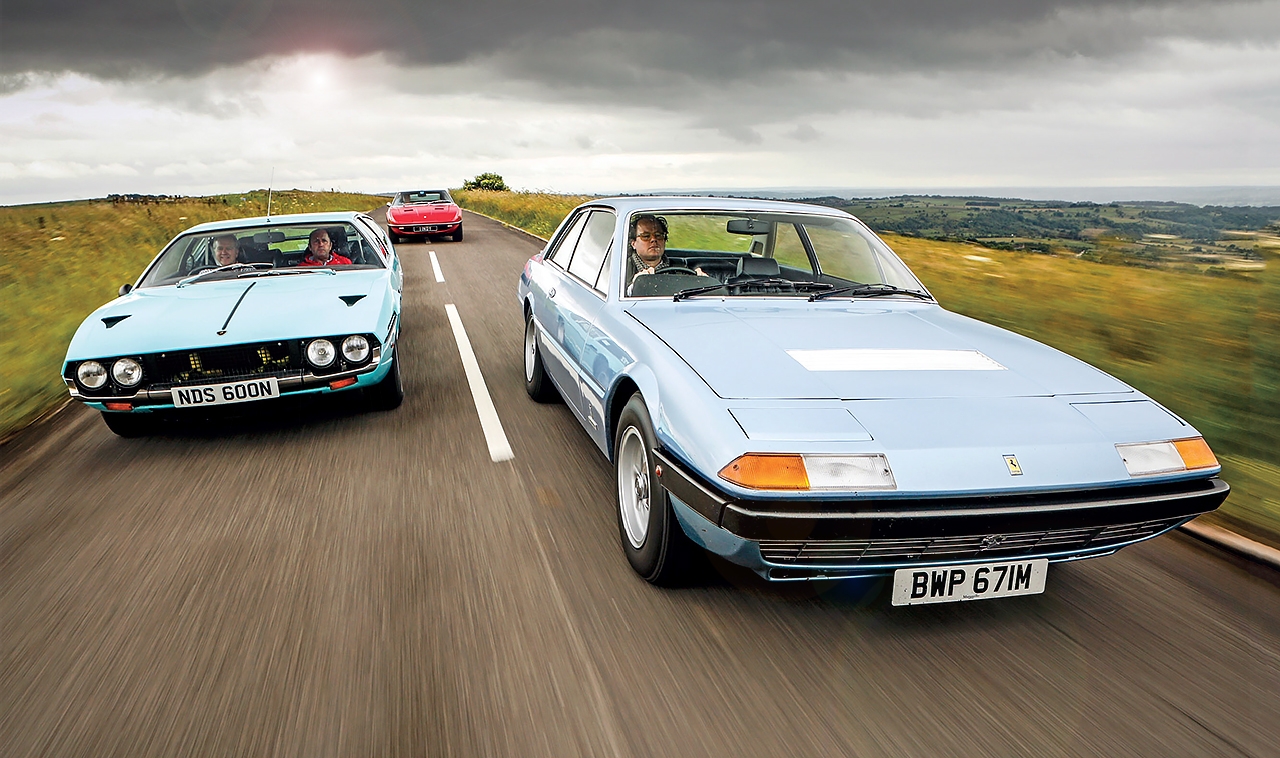
Performance without compromise Ferrari 365GT4 vs. Lamborghini Espada and Maserati Indy. Family supercars! Exotic looks, 150mph performance and 2+2 practicality. Espada locks horns with Indy and 365GT4. Practical performance. Family-friendly 150mph GTs from Ferrari, Lamborghini and Maserati. Supercar needn’t mean mid-engined plaything, says Martin Buckley as he samples a grown-up trio from Ferrari, Lamborghini and Maserati. Photography Tony Baker.
The Maserati Indy, Lamborghini Espada and Ferrari 365GT4 2+2 were among the first hyper-exotic Italians designed not just as trinkets for the rich, but cars that had to earn their keep as tools of both business and pleasure.
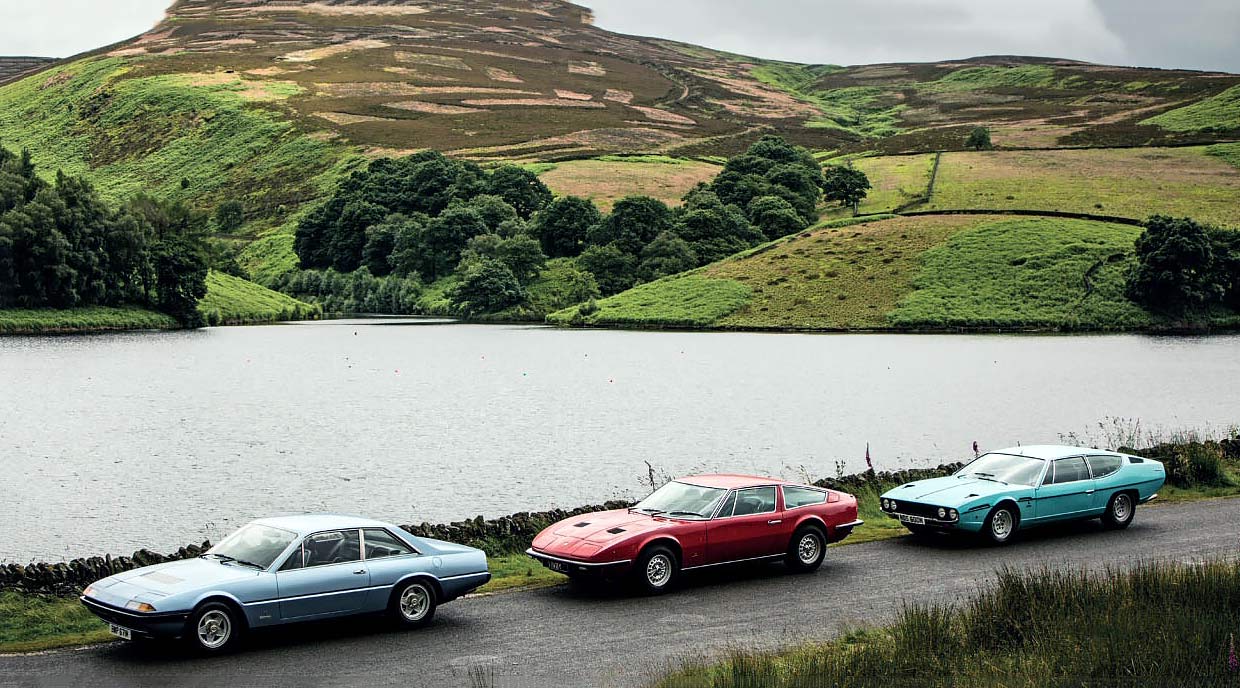
The very utility of these glamour machines was, and remains, intrinsic to their appeal. Harnessing quad-cam V12 or V8 power to the job of transporting four people rather than two always seemed, to me, a noble ambition rather than an unfortunate marketing compromise. But then I am one of those weird people who never really lusted after Boxers, Boras or even (dare I say it?) Miuras. I was glad that they existed but somehow I never really wanted any of those mid-engined pin-ups. What would I do with one? Where would I go?
Not so these four-seaters. Having handed over a reassuringly outrageous sum of money for the privilege (well in excess of the cost of the average UK home in the depressed mid-’70s or, if you prefer, four grand more than a Silver Shadow) these were cars in which the high net worth individual and his family could travel in close-coupled luxury at more than 150mph. The Espada, Indy or 365GT4 owner could put his golf bag in any of their sensibly proportioned boots, take friends out to dinner, blast across Europe, or just go to the shops, safe in the knowledge that he was unlikely to encounter anything faster or more capable.
As values of their two-seater contemporaries go stratospheric, these exotic GT cars are having their day at last. That said, they are still quite ‘approachably’ priced if you happen to have a spare £70-120k floating around. What that also means is that owners are now confident enough to spend serious money having them restored and maintained, which is good for the cars.
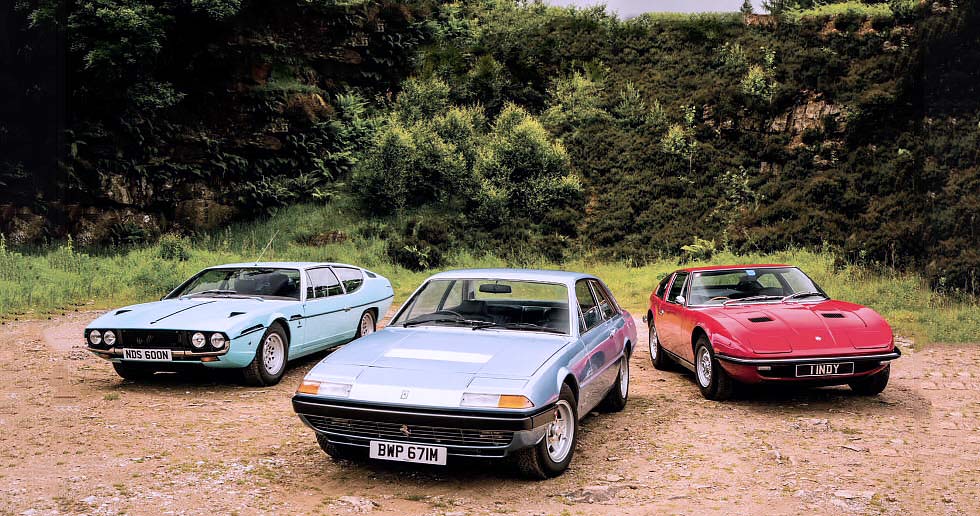
What is often overlooked by those who once sought to mock them (and people did sneer at family-sized supercars such as these in the days before they reached their current values) is that the Indy, Espada and 365GT4 actually sold in meaningful numbers by the standards of the day. Never enough to make them exactly commonplace, but sufficiently so as to generate both profit and volume in a world that was looking increasingly bleak for manufacturers of exotica.
The figures speak for themselves. At 1200 units from 1968-’1978, until recently the Espada was the best-selling model in Lamborghini’s history. The Indy (1969-’1975) almost matched it and, if you lump the 365 and 400GT together, from 1972-’1979 you get almost 1000 examples of the Ferrari – not bad considering that the firm had pulled its V12s out of the North American market by that time. Sales of its forerunner, the 365GT 2+2 of 1967-’1971, had accounted for 50% of total Ferrari sales during that period, so there was no doubt that the customers were there for the right car. The appeal (and potential profit margins) were well understood.
‘THE ESPADA’S AS MUCH OF A TRAFFIC-STOPPER AS ANY MID-ENGINED FANTASY MACHINE’

Espada’s Bertone styling is unsurprisingly the most outrageous of the three cars. Note the shape of side windows, which ape the Miura’s door glass.
Although it looks the youngest, the Espada arrived first, at Geneva in 1968. Inspired by the Marzal show car, it set the tone of the debate about four-seater supercars for the next decade. It also demonstrated that it was possible to make a GT that was as much of a traffic-stopper as almost any mid-engined fantasy machine. Forty-eight years on, it still makes a statement like almost nothing else. Wide and squat, it is not as long as it initially appears. Neither is it straightforwardly beautiful. Striking, dramatic, and futuristic, yes, but the Espada isbynomeans conventionally good looking.
The beauty of the engine is not in doubt, however. The massive aluminium bonnet tips forward to reveal a 350bhp 4-litre oversquare V12 that, in this case, is no stranger to the engine detailer’s attentions. It is all gleaming ribbed aluminium cam boxes with a superbly engineered throttle linkage that promises millimetre-perfect control of the six twin-choke Webers.
Property of long-term Espada enthusiast Cliff Graham, this car is a Series 3, which means bolt on wheels rather than Miura-style knocks-ons.
On the other hand, there’s the promise of the apparently all-important ZF power steering – a feature shared by all of these cars, in fact. Like most Espadas, it has had at least one famous owner – in this case U2’s Bono, in the days before he started saving the planet. In their prime, they appealed to everyone from Paul McCartney to Gerald Ronson and, yes, even Jimmy Savile, who had one of the extremely rare S3 automatics. Only about 10% of Espada production was right-hand drive, and not all of those came to the UK. Graham reckons there are about 25 of all series combined still on the road here. He regularly drives his car to work and says that the model’s troublesome reputation is largely a myth. “Properly maintained and regularly used they are bullet-proof,” he asserts, “but you do need to have the rust and electrical problems sorted out.” Easier said than done: Bertone’s welded monocoque is a masterful piece of packaging but was never exactly durable – even the roofs rusted. Yet the Espada was surprisingly usable: some people towed caravans with them.
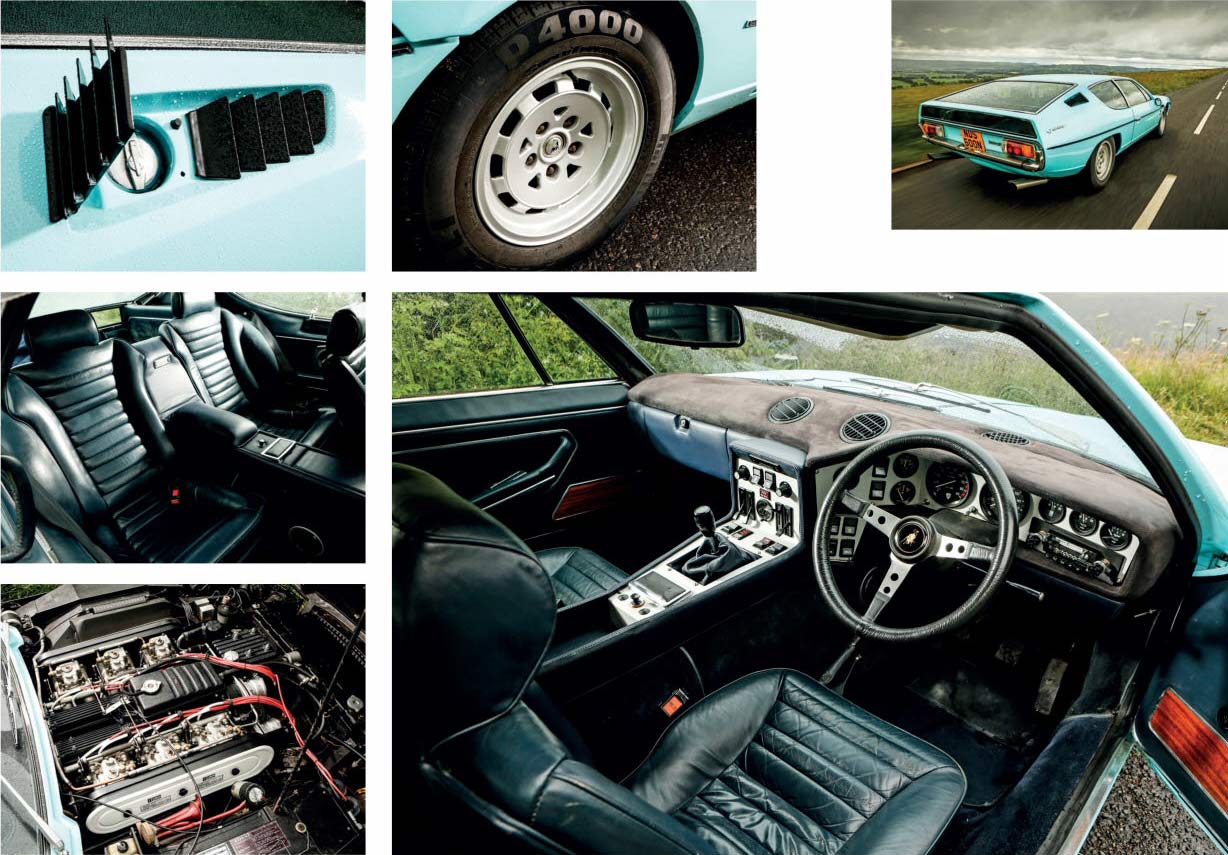
Clockwise, from left: unexpectedly plain alloys on the extrovert Espada; car’s wacky fascia has an aviation feel, with switchgear and even the stereo grouped around the driver; V12 shared with Miura but here it’s placed longitudinally at the front; remarkably spacious rear seats; fuel filler is hidden beneath fake air vent.
Both the Indy and the 365GT4 2+2 were calculated reactions to the success of the Espada, although only the Maserati copied the Lamborghini’s rear hatch. Their designers homed in on producing 4000lb cars that could take four people roughly 300 miles between fill ups (depending on whether they wanted to cruise at 100 or 130mph) in the maximum luxury that buyers of such vehicles were becoming accustomed to. There were differences in both detail and overall concept, though. The Ferrari kept a traditional tubular chassis, whereas the Vignale-bodied Indy used a steel monocoque developed from the Quattroporte saloon that it in effect replaced post-1970. Slightly longer and taller than the Ghibli, the Indy came with 4.2, 4.7 or 4.9-litre versions of the quad-cam V8. The last, badged Indy America, was intended for coupling with automatic transmission.
Michael Roberts’ Maserati, which he has owned for 24 years, is a 290bhp 4.7-litre right-hand- drive car with the German ZF manual ’box – a clue to the character of a model that relied on more bought-in componentry than you might expect. There’s also a Salisbury rear axle and Jaguar-type Alford and Adler front suspension.
The power unit is all Maserati, though, and like the other two, the engine bay it lives in is a gleaming showpiece. With its massive black cam covers, the V8 looks somehow less intimidating to work on than either of the V12s. Roberts loves the Indy because it is “practical, but special…and the last of the traditional Maseratis”. He confirms that it is “pretty reliable” and much safer in the wet than the Merak he owned before it.
If the Tipo AM 116 Indy was a product of Maserati’s pre-Citroën era, and thus the last of the rigid-rear-axle cars powered by the quad-cam V8, the 365GT4 2+2 (4.4 litres, four camshafts and four seats) was very much a car of the Fiat management era. It was probably the most thoroughly sorted V12 Ferrari to date in terms of refinement and finish, as well as the roomiest and, at a claimed 160mph, among the fastest.
‘THE INDY’S HUSKY PICKUP IS DELIVERED WITH A SWEET, SMOOTH AND SUSTAINED THRUST’

Indy seems narrower and more upright than its rivals but is a fine-looking car and provided a visual link between the Ghibli and mid-engined Merak.
Pininfarina clothed it in a conservatively chisel-edged shape that cleverly disguised a wheelbase 2in longer than that of the Espada, but it has the least rear legroom here and the shallowest boot.
Sold originally to Peter Morgan (yes, that Peter Morgan) in 1974, you can tell that this one is a 365 (rather than a later 400/412) by its knock-on Cromadoras, its sextet of rear lights and the absence of a chin spoiler spoiling its chin. Current owner Oliver Eaton recently had the GT4 recommissioned (at a hair-raising £275 an hour) by Maranello Sales in Egham. The jury is out on reliability – the car was about to go back to have its handbrake fixed – but Eaton does use it for the occasional school run.
It would be a mistake to get too hung up on such practicalities, though. These cars can endure life’s chores, but they come alive when you drive them just for the sake of it, and you can learn quite a lot about their characters just sitting in them. Open the long, heavy doors, smell the leather and slip inside.
You sit lowest in the Lamborghini (rather knees-up), fairly commandingly in the Ferrari but probably the most comfortably in the Indy with its adjustable wood-rim steering wheel and deep, spacious foot wells. The chunky leather trimmed wheels of the 365 and the Espada are delicious to the touch. All three have air-conditioning, big manly pedals, tycoon-sized ashtrays, random minor controls and a bare minimum of half a dozen minor instruments on swooping centre consoles that split the cabins in two.
There is a ’70s modular theme to the Ferrari’s dials, whereas the Espada’s silvery dash is something akin to a light aircraft, with lots of separate switches; the other two go for more ergonomically intuitive column stalks. The Indy’s interior is the least styled of the three; its minor gauges are thoughtfully angled towards the driver, but the twin tanks encroach on the open-plan luggage area. As in the Lamborghini, your goods and chattels are on display under a glass hatch. Scrabble into the rear of the Espada and you’ll find that it is emphatically the roomiest for backseat passengers. It’s quite an airy and pleasant place to be, and the aircraft theme continues with windows that are top-hinged outwards for ventilation like those of a Beechcraft. The Maserati isn’t far behind in leg space (but is a little short on headroom), while in fairness to the GT4, Ferrari never claimed that it was anything more than an occasional four-seater.
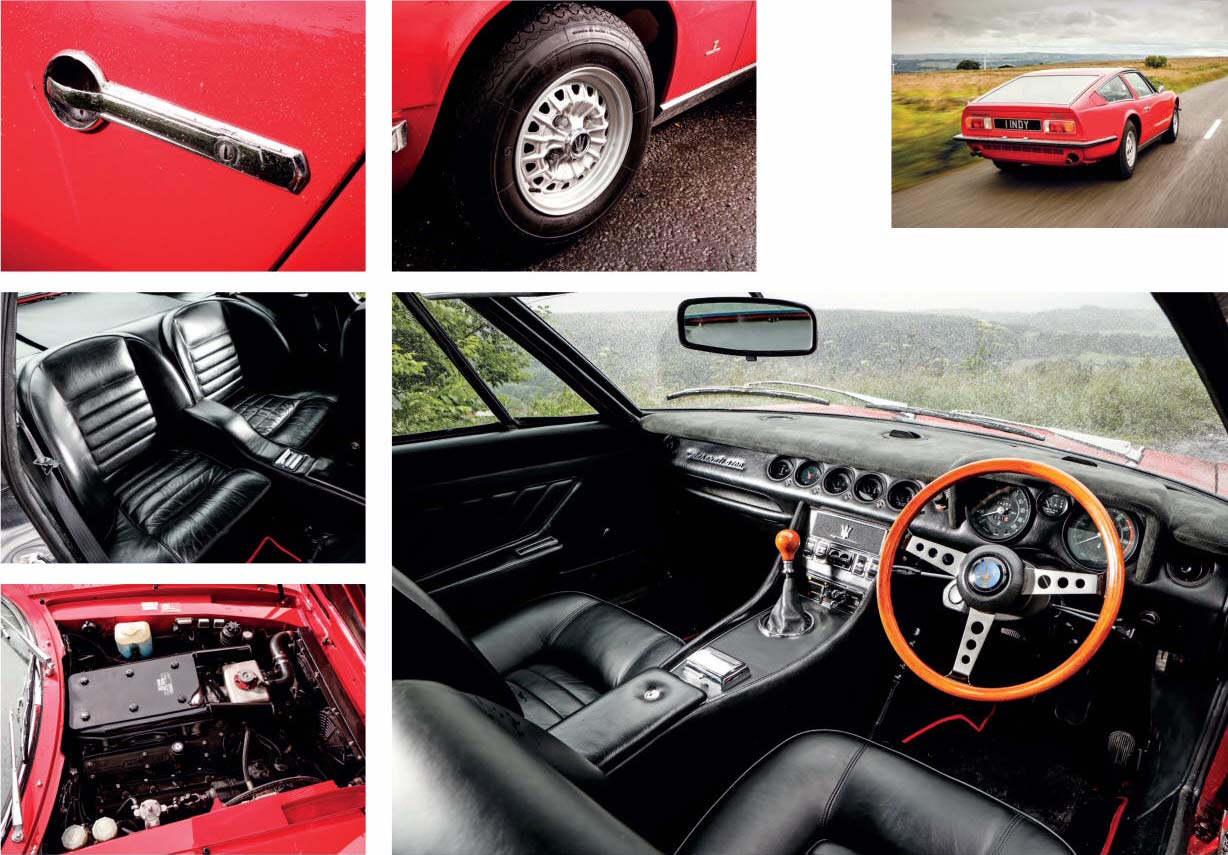
Clockwise, from far left: stylish details abound, including unusual doorhandles and pretty alloys; architecture of the Indy’s cabin has more of a ’60s ambience than those of its rivals, reinforced by woodrim wheel and gearknob; V8 looks less daunting to home mechanics than the V12s; individual rear seats hold passengers in place.
On the road you don’t give much thought to ride in either the Ferrari or Lamborghini at first, although somehow the huge expanse of bonnet on the Espada tends to suggest the front end is floating a little. With wishbones and coils at each corner they take most surfaces in their stride, the Ferrari enjoying the additional sophistication of automatic self-levelling on the back. The Indy has a conspicuously firmer ride over anything other than very smooth roads but is in other respects the most refined of the three in terms of road, wind and engine noise. Its V8 gives away 50-60bhp to the V12s, but the husky pick-up is everything you could wish for, delivered with a sweet, smooth and sustained thrust from 2000 to a conservative 5500rpm. It has a suave and discreetly expensive exhaust note, which makes more noise than an engine that has admirably quiet valve-gear. There’s also a nicely spaced set of ratios in a gearbox that gets slightly loud with the oil hot, but which is otherwise a pleasure to use – although it cannot be rushed.
The Maserati feels very stable, slips its chiselled jaw through the air effortlessly and has wieldy, balanced handling that seems to amount to more than the sum of its parts. By taming axle tramp and making the car relatively roll-free – as well as ensuring 50:50 weight distribution – Alfieri arguably perfected the post-war Maserati GT concept with the Indy. The only flaw in that argument that I could find was the brakes, which were potent but had too much pedal travel.
‘A SUSTAINED RUSH IS THE ESSENCE OF WHAT THESE CARBURETTED V12S ARE ALL ABOUT’
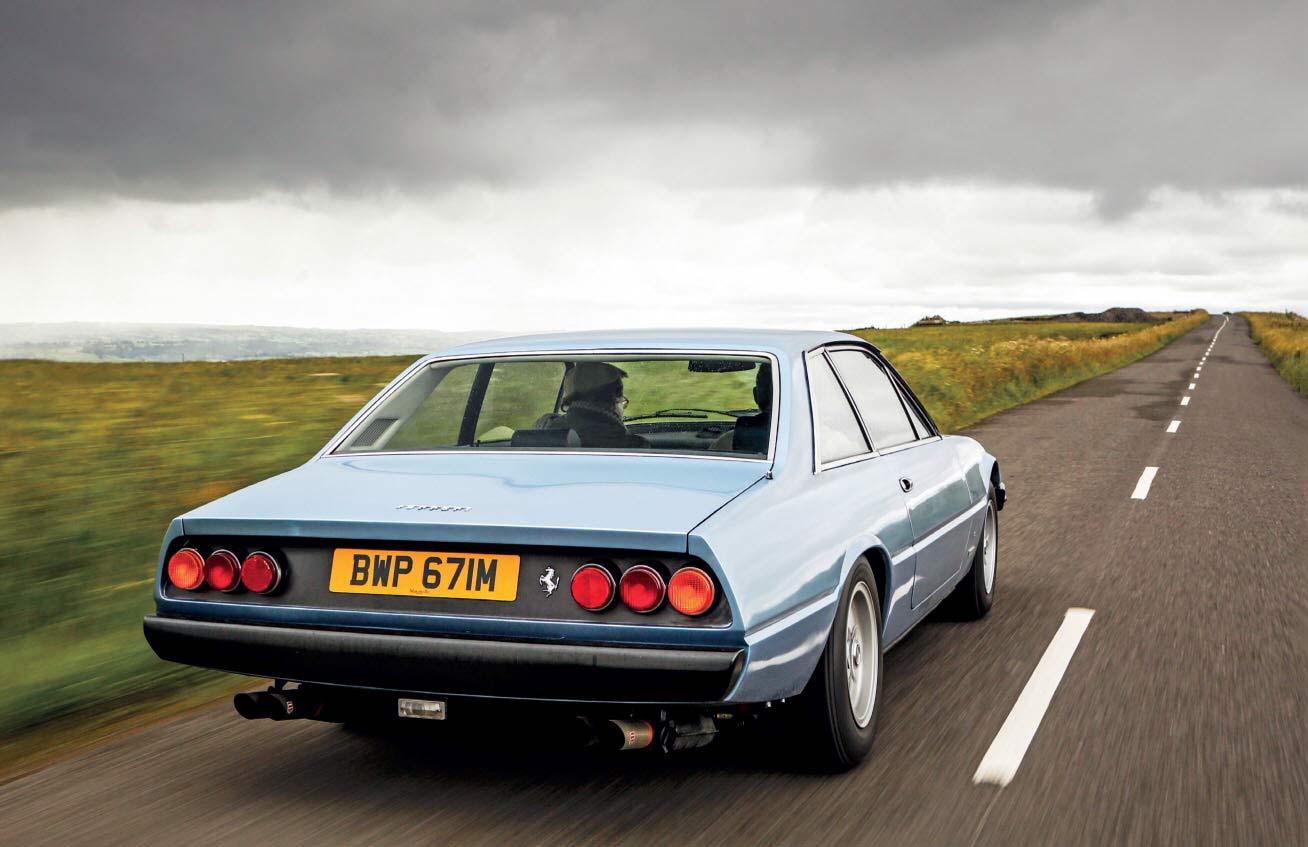
Sober lines of the 365 are the least striking here but there’s a subtle elegance to the Pininfarina shape. Note six tail-lights – later incarnations had only four.
Drive it for a while longer and you begin to think that you could live with this rather grownup supercar. In some respects, it gets nearer to the ‘Italian Rolls-Royce’ ideal than does the Lamborghini, which is as flamboyant as the Indy is (relatively) introverted. But that’s the point of the Espada isn’t it? Standing no more than waist high, it seems to go everywhere with a hysterical yowl – a gentle plume of blue smoke from the left exhaust is also pretty standard, so I’m told.
You actually have to rev it quite aggressively to extract the performance, using the lower gears to keep the revs up, althought that’s hardly a chore. That is not to say that the V12 lacks flexibility, which would of course be absurd. In fact it is supremely tractable at low speeds, helped by the smoothness of the clutch and the precise modulation of the throttle as you feed in the power.
Real urge doesn’t come steaming in until you hit 2500 or 3000rpm, but then you’re away. When it was new, the V12 could safely rev to nearly 8000rpm (that’s110mphin third) but even using a lusty 6000 as a limit, the Espada is quick.
Straights are dissolved in silky, sustained lunges, the apparent bulk shrinking rapidly. And as you pour it through curves, squeezing on the power to counter the (slight) understeer, you become increasingly conscious that the ride is very good.
You sit so very low – all four of you – in this unexpectedly friendly, good-natured car. With its genuinely useful glazed tail it’s great for reversing and has an amazingly nifty turning circle. That’s just an added benefit of the pleasingly geared and weighted steering, which you only really notice is powered when parking. The big wooden gearknob, just a hand’s span from the wheel, controls a meaty, precise change that invites punchy, decisive shifts. They feel so eager and crisp, you quietly admit that the automatic Espada was really a bit of an abomination.
The Ferrari is elegant and sharply tailored like A good suit, but only the silky timbre of its exhaust note turns heads. When it was launched at the Paris Salon in ’1972, there were those who thought that the sober lines – penned by the masterful Aldo Brovarone – were a disappointment. What they couldn’t know was that the basic shape would have an 18-year production run, the longest of any Ferrari by a very long way.

Clockwise, from left: Michelin 70-profile XWXs are de rigueur on 1970s supercars and ensure a decent ride; broad console sweeps into well-stocked fascia; quad-cam V12 is fed through six Webers; heavily bolstered seats but the Ferrari is the least roomy here; chassis number sits on a plate behind the steering wheel.
Because Maranello and Sant’Agata came to such broadly similar technical conclusions, the two V12s feel largely similar to drive. Possibly the 365 launches a little stronger and pulls a little harder beyond 100mph. It has similarly immaculate throttle feel and response (although the Webers gag if you mash the throttle too suddenly from low speed) and the power just keeps on coming; the sustained rush is the very essence of what these multi-carburetted V12s are all about.
If the Ferrari’s 0-60 in 6.6 secs and 120mph in 21 are not going to set anyone’s trousers alight today, remember that this is not a footballer’s toy but a sophisticated GT that delivers the goods with turbine smoothness from 2000-7000rpm.
The wide power band is perfectly matched to the ratios in a smooth-shifting gearbox with a particularly light, sweet clutch. Only a twitch of the rev counter acknowledges that you have changed up and you just keep on pulling. You can break the law in second and get yourself banned for a month or two in third – still with two gears to go.
The 365 has great vision all round, although a much grander turning circle than the Espada. It rides with similarly light-footed aplomb on its squidgy, doughnut-like 205-section Michelin XWXs (essential supercar-wear in the mid-’70s) and takes confident command of any cornering situation you are likely to encounter. Steering that is positive but far from twitchy, plus the choice of gear ratios – combined with such delicious throttle response – mean you can tune your cornering attitude at will, depending on how the curves unfold. Like the Espada, the Ferrari is compelling, flattering and generous to drive fast. I loved the 365, but then I loved all three of these cars. The Indy is charming and swift but really comes from a slightly different generation.
Under its hip Vignale body lies the sort of ’50s technology that is part of its no-nonsense appeal, but one could take a less generous view and dismiss it as an Italian Jensen. The Maserati just lacks its V12 rivals’ fine edge of driver appeal, but does have many compensating virtues.
The 365GT4 symbolises the moment when Ferrari got its act together and went corporate. In a way, it has an appeal that slips neatly between the Indy and Espada, combining the mechanical excitement of the latter with the conservative, traditional appeal of the former. Perhaps it was a supercar designed for the world as it was, rather than the way people may have wanted it to be. No, you have to love the Espada. It’s still in my Top 20 and I can see why the prices have taken off in recent years. It is a true fantasy machine that, in its way, was as audacious as the Miura. If some of the fairy dust from that most drooled over of supercars is starting to rub off on this Italian spaceship, it’s about time.
Thanks to Michael Roberts, Oliver Eaton, Cliff Graham; Maserati Club UK; Lamborghini Club UK; Tony Willis at the Maranello Sales archive
TECHNICAL DATA Ferrari 365GT4 2+2
Sold/number built 1972-’1976/524
Construction tubular steel chassis, steel body with glassfibre floor, alloy bonnet and bootlid
Engine front-mounted, all-alloy, dohc-per-bank 4390cc V12, with six twin-choke Webers
Max power 325bhp @ 6200rpm
Max torque 311lb ft @ 4600rpm
Transmission five-speed manual, RWD
Suspension double wishbones, coil springs, anti-roll bars; telescopic front dampers, selflevelling rear struts
Steering power-assisted ZF worm-and-roller
Brakes discs, with servo
Length 15ft 9in (4801mm)
Width 5ft 11in (1803mm)
Height 4ft 4in (1321mm)
Weight 3307lb (1500kg)
Wheelbase 8ft 10 ½ in (2700mm)
0-60mph 6.6 secs
Top speed 152mph
Mpg 12
Price new £14,266 (1975)
Now £70-120,000
Hybrid alternative
Impressive though our trio may be, with their fiercely complex powerplants it’s natural to feel some trepidation when faced with the prospect of ownership. The answer, of course, has long been known – a lazy mass-produced American V8 dropped into a bespoke chassis and body. Over the years there have been many such hybrids, but one of the most intriguing must surely be the Monteverdi High Speed 375L.
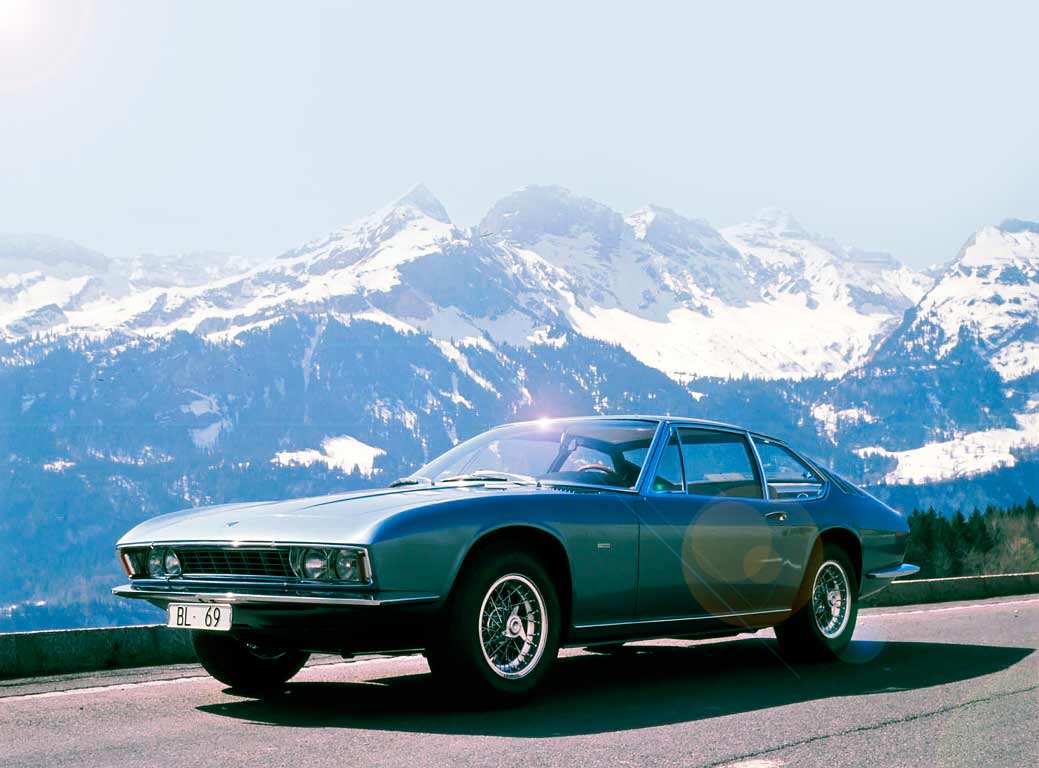
Unlikely to be recognised by all but a few hard-core cognoscenti, just like the Lamborghini it owes its existence to Enzo Ferrari’s ability to upset people – in this case, Swiss Ferrari importer Peter Monteverdi.
Launched in ’1967 and powered by a 7.2-litre Chrysler V8, this four-wheeled vendetta was good for 0-60mph in 6.3 secs and 152mph. At 3920lb, it’s no waif but with its de Dion rear and an engine set well back in the chassis it handled with aplomb. It’s a real looker, too. Styled by Monteverdi, the body was built by Frua until another argument led to Fissore taking over. Production numbers are notoriously vague, but range somewhere from 50-200 cars.
TECHNICAL DATA Maserati Indy
Sold/number built 1969-’1975/1104
Construction steel monocoque
Engine front-mounted, all-alloy, dohc-per bank 4719cc V8, with four twin-choke Webers
Max power 290bhp @ 5500rpm
Max torque 282lb ft @ 3800rpm
Transmission five-speed manual, RWD
Suspension: front double wishbones, coil springs rear live axle, semi-elliptics; telescopic dampers, anti-roll bar f/r
Steering power-assisted ZF recirculating ball
Brakes discs, with servo
Length 16ft (4877mm)
Width 5ft 10in (1778mm)
Height 4ft 3in (1295mm)
Wheelbase 8ft 6 ½ in (2600mm)
Weight 3638lb (1650kg)
0-60mph 7.5 secs
Top speed 156mph
Mpg 14
Price new £9654
Price now £65-100,000
TECHNICAL DATA Lamborghini Espada
Sold/number built 1968-’1978/1217
Construction steel monocoque, with aluminium bonnet
Engine front-mounted, all-alloy, dohc-per bank 3929cc V12, with six twin-choke Webers
Max power 325bhp @ 6500rpm
Max torque 290lb ft @ 5500rpm
Transmission five-speed manual, RWD
Suspension double wishbones, coil springs, telescopic dampers, anti-roll bar f/r
Steering power-assisted ZF worm-and-sector
Brakes discs, with twin servos
Length 15ft 6 ¼ in (4730mm)
Width 6ft 1 ½ in (1867mm)
Height 3ft 11in (1195mm)
Wheelbase 8ft 8 ½ in (2650mm)
Weight 3875lb (1761kg)
0-60mph 6.5 secs
Top speed 158mph
Mpg 14
Price new £12,113 (1974)
Now £80-150,000
{CONTENTPOLL [“id”: 71]}





